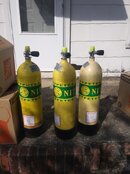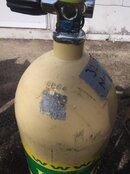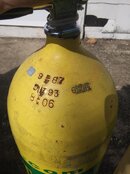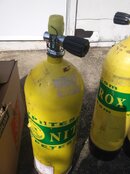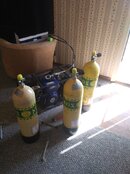Paint remover will work on one of the tanks (not the one with the vinyl). Even on that one it is going to be a mess.
I have used that type of paint remover on aluminum tanks, but paint (even factory paint) doesn't adhere as well to aluminum.
The paint adhesion to the galvanize surface is excellent.
The paint remover will make the paint bubble and blister, but that mess still has to be scrapped off. And what is the point. If it just for looks... I rather be diving.
This paint actually does protect the galvanizing coat from wear.
The vinyl coating is a different story. I would not even try paint remover on that one. The coat is so thick that even if the paint remover does anything to it... all it is going to do is make a huge mess.
The vinyl can be actually cut and stripped in pieces, but it is just going to be a lot of work. When cutting it you want make sure not to scratch into the galvanizing coat. Again I personally don't think it is worth the trouble and the risk of doing any harm to the galvanizing (when cutting into the vinyl). And this coating is also protecting the hot-dipped galvanizing coat. So I would not mess with it.
Granted, the hot-dipped galvanizing on both cylinders is the best protection ever to steel cylinders, but the extra factory coating doesn't hurt it and it can protect it, so why mess with it? Again, I am into diving... not creating big projects... YMMV
BTW, I always use a paint marker pen on the hydro stamps of all my steel cylinders. The stamping sometimes just barely cuts into the hot-dipped galvanizing. So the paint pen protects the little line of exposed steel and it highlights the hydro date.
I have used that type of paint remover on aluminum tanks, but paint (even factory paint) doesn't adhere as well to aluminum.
The paint adhesion to the galvanize surface is excellent.
The paint remover will make the paint bubble and blister, but that mess still has to be scrapped off. And what is the point. If it just for looks... I rather be diving.
This paint actually does protect the galvanizing coat from wear.
The vinyl coating is a different story. I would not even try paint remover on that one. The coat is so thick that even if the paint remover does anything to it... all it is going to do is make a huge mess.
The vinyl can be actually cut and stripped in pieces, but it is just going to be a lot of work. When cutting it you want make sure not to scratch into the galvanizing coat. Again I personally don't think it is worth the trouble and the risk of doing any harm to the galvanizing (when cutting into the vinyl). And this coating is also protecting the hot-dipped galvanizing coat. So I would not mess with it.
Granted, the hot-dipped galvanizing on both cylinders is the best protection ever to steel cylinders, but the extra factory coating doesn't hurt it and it can protect it, so why mess with it? Again, I am into diving... not creating big projects... YMMV
BTW, I always use a paint marker pen on the hydro stamps of all my steel cylinders. The stamping sometimes just barely cuts into the hot-dipped galvanizing. So the paint pen protects the little line of exposed steel and it highlights the hydro date.




